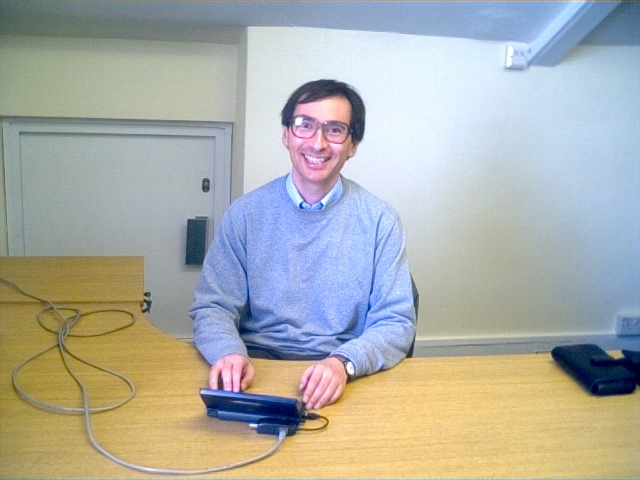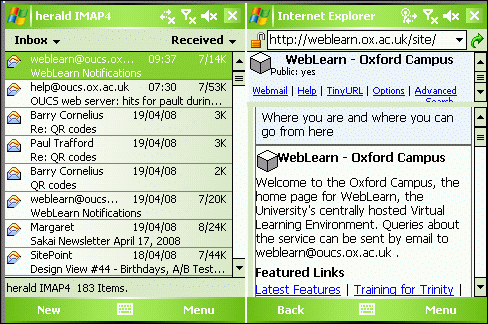Mobility has become the key characteristic of our period. Social and physical mobility, the feeling of a certain sort of freedom, is one of the things that keeps our society together, and the symbol of this freedom is the individually-owned motor-car. Mobility is the key both socially and organizationally to town planning, for mobility is not only concerned with roads but with the whole concept of a mobile, fragmented, community.
[Alison and Peter Smithson, Team 10 Primer, 1962?]
Today we have virtual highways in which mobile phones are the vehicles, which for many symbolise freedom of expression. But do these material enablers lead to mental crutches? How can such freedom be used for our well-being, particularly in education?

I’ve been interested in mobile/handheld/portable computing on and off since the late 1970s, when as a child I used to play with pocket calculators (a Texet 880 and the ‘Little Professor’). Much later I came across general-purpose handheld computing with the Psion devices, but I didn’t own any until a trio of Hewlett Packard devices, namely: HP 320LX, HP Jornada 568, and HP Jornada 720.
Until about 2004, this was mainly a personal interest, where I wiled away many an hour in experimentation, until the Learning Technologies Group at Oxford University gave some formal support, allowing me to bid for and subsequently manage an externally-funded project, RAMBLE (on top of my usual work, of course!). Seeing its growing importance, in subsequent years (mostly in my personal time) I promoted the strategic thinking around mobility and ubiquity, and gained sufficient impetus to set up at the beginning of 2008 a Mobile Special Interest Group at OUCS, that gained 20 members across the different sections.
This galvanised interest and led to some important university-wide developments; by April it had become incorporated in graduate skills training.

The links below provide an archive of developments from an earlier decade, which are still useful, especially for the rationale.
- Using X applications on an HP Jornada 720 (2003) — just an intimation of what is possible. The underlying issue concerns thick vs thin computing, especially relevant concerning the delivery of Web content to handheld devices (compare e.g. Opera 9.5 with server-side solutions from the likes of Skyfire).
- RAMBLE (2004-5) — Remote Authoring of Mobile Blogs for Learning Environments, JISC-funded project concerning mobile blogs and their integration in institutional learning environments.
- Mobile Blogs, Personal Reflections and Learning Environments (2005) A broad overview from Issue 44 of the Ariadne online journal
- Handheld Musings (2004-10) — a personal blog, with various thoughts, especially on OxPDA, an educational assistant to replace the Oxford University pocket diary.
- OxPDA: Pervasive e-Learning in your hands (2005) — Part 1 / Part 2 / Part 3, Handheld Musings blog posts.
- From Portability to Ubiquity — What do we mean by ‘Mobile’? (2007)
- OxMobile: Towards a Mobile and Ubiquitous Strategy for the University of Oxford (2008) — a report detailing context, present status and various project proposals to really start embracing handheld and mobile technology at Oxford.
- Notes from an Emerging Mobile SIG at OUCS — A presentation I gave on my last day as SIG coordinator (I was shortly to leave the department to pursue full-time studies).
- Erewhon (2008-9) This strangely named project concerns the development of location-based services, building on a number of initiatives at OUCS, and led to the production service, Mobile Oxford (m.ox.ac.uk), as presented at the 2010 ITSS conference and documented in the WebLearn VLE. It can be seen as a step to fulfilling some of the vision in OxMobile (Tim Fernando remarked that he has used the posts as a kind of checklist).
(My list of mobile devices has since grown to include the HP iPAQ 1940, Asus Eee PC (first and later generations), Sony Ericsson Xperia Mini, Amazon Kindle, Palm Phone, and iPhone SE.
Pause for Thought
So, what of the quote above? It reminds me of the phrase “car-owning democracy,” much cherished in the 1980s. However, it can be argued that the motor car was a symbol of an acquisitive approach has not led to greater well being — Avner Offer’s The Challenge of Affluence gives plenty of food for thought.
Will mobile devices with all their options for personalisation merely encourage a form of consumerism that fails to enrich us as human beings? What about personalisation as a general principle…? How many different ways of serving tea and coffee do we really need?
This page was published on 9 April 2016 and last updated on August 10, 2022.